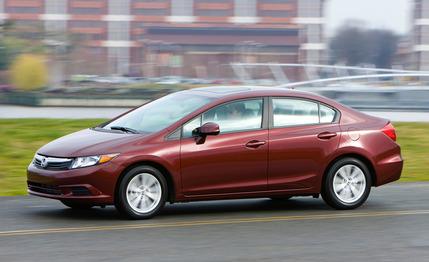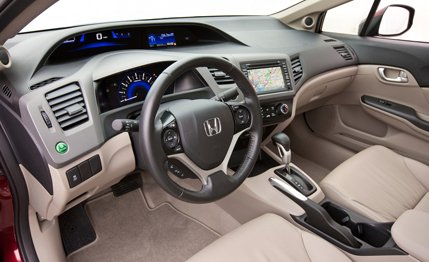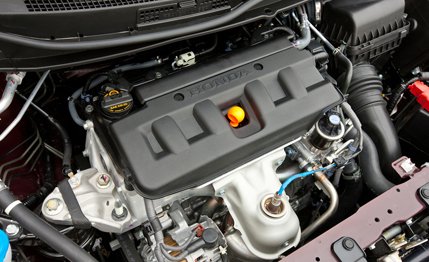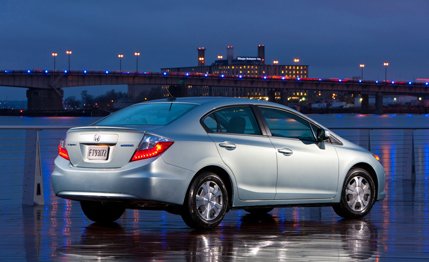
 First Drive Review
First Drive Review
Read our first drive of the 2012 Honda Civic Si here.
Honda sells so many Civics that if the car were counted as a brand, it would be the 12th largest in the United States. More Civics went to new homes in the U.S. last year than did Volkswagens or Mazdas. With sales numbers like that, it’s not too much of a surprise that Honda is playing a conservative hand with the redesigned 2012 Civic.
When the previous-generation Civic arrived in 2006, the swept-back windshield and the futuristic styling were a bit of a shock. It has taken us practically the car’s entire life cycle to grow accustomed to the look. Honda designers aren’t taking the same kind of chance again. What we see for 2012 is a careful evolution of the past Civic. Actually, it’s almost more of a devolution, a step toward conformity. All the subtle changes—the longer hood, the sculpted bumpers, and the larger taillights—make the Civic look more conventional than before. They also improve its aerodynamics. Honda claims a lower coefficient of drag, in part thanks to the styling revisions but also because of a smaller grille opening and a flat underbody.
Still Alien Inside
Inside, the Civic keeps the two-tier instrument display that puts the digital speedometer above the analog tachometer. Like the exterior, the interior is immediately familiar yet new. Plastic quality improved slightly, and there is interesting rice-paper-like graining on the door panels. Thinner A-pillars aid forward visibility, and new seats feel more supportive—mercifully, they have less-intrusive lumbar support. A new five-inch display is standard on all models above the most basic DX trim level. Dubbed the “intelligent Multi-Information Display,” the screen sits to the right of the speedometer and gives trip computer, audio, clock, and (on cars so equipped) navigation information.


Although the sedan’s 105.1-inch wheelbase is now 1.2 inches shorter, rear legroom increases by 1.6 inches. Overall length, height, and width all remain unchanged, but the Civic feels wider and more spacious inside. Honda claims shoulder room has increased by nearly three inches. The front passenger certainly feels farther away than before. According to the EPA, the new Civic sedan has 94.7 cubic feet of space inside. That works out to about four more than in last year’s car.
Civic coupes have an even shorter 103.2-inch wheelbase, 1.1 inches shorter than the outgoing model’s. Interior space falls slightly from 83.7 cubic feet to 83.2, or 82.6 with a sunroof. From the front seat, the coupe feels just as spacious as the sedan. The reduction in cubic feet must have come at the expense of the back seat, which we didn’t try to climb into. Would you?
Same Size but Drives Larger
Once we were under way, the impression of increased size and a more substantial feel continued. Tweaks to the strut front and multilink rear suspension yield more travel and a slightly smoother ride. Large impacts seem more distant than before and are absorbed by a unibody structure that is slightly more rigid. Not only is it stiffer, but it’s also slightly lighter than before. The greatest weight loss, 58 pounds, occurs in the EX-L sedan. Other versions are between 20 and 55 pounds lighter than they were last year.
Modifications to the electric power steering include a slower ratio and a rack that is more rigidly mounted. Compared with its predecessor, the new Civic turns into corners with less authority, which adds to the car’s larger feel. The electric power steering is very numb, providing less feedback than before. Overall, the car’s stiffer body, increased sound deadening, and sleepier steering are more about maturity than playfulness. There’s a greater sense of isolation from the road, and drivers who equate isolation with luxury will appreciate the changes. Drivers who relished the small-car—almost sports-car-like—personality of the Civic might be disappointed.


Don’t I Know You? And You?
With the exception of the performance Si model and the fuel-sipping hybrid, every Civic sedan and coupe (DX, LX, EX, and EX-L) will have a 1.8-liter four-cylinder engine with 140 hp and 128 lb-ft of torque. (The natural-gas-burning GX also uses the 1.8.) Essentially a carry-over from the previous generation, the engine does enjoy a few changes that add a bit more torque down low and reduce internal friction. The four-cylinder still spins happily, but less of the noise enters the cabin. Without that noise, the engine doesn’t seem to be working as hard as it did in the ’11 Civic.
Another carry-over part is Honda’s five-speed automatic transmission, an $800 option on the lower two trim levels, DX and LX, and standard on all others. A few updates like reduced friction and more-eager torque-converter-lockup programming help boost fuel economy to 28 mpg city and 39 highway for automatic models. (Last year’s automatic returned 25 city and 36 highway.) Meanwhile, purists will be a little disappointed that the five-speed manual can only muster 28 city and 36 highway, up from 26/34.


Buyers seeking even higher fuel-economy numbers will want to consider the hybrid model or the new Civic HF. Available only as a sedan with the automatic, the HF adds lightweight aerodynamic wheels, a small trunklid spoiler, a few more underbody panels, and extremely low-rolling-resistance tires that bump highway fuel economy to 41 mpg; the city number rises by 1 mpg, to 29.
Pricing for the 2012 Civic is largely unchanged from the 2011 model’s. The cheapest version, the DX coupe, starts at $16,355; its sedan counterpart starts $200 higher at $16,555. The LX adds important items such as A/C, power locks, and cruise control, as well as $2050 to the sticker of both the coupe and sedan. For $20,455 (coupe) or $21,255 (sedan), the EX heaps a sunroof, an upgraded stereo, and another 12-volt power outlet on top of the LX. (EX coupes are available with the manual, but EX sedans only come with the automatic.) Another $1500 nets an EX with nav—and removes the option of a stick in the coupe—and $1450 more gets an EX-L—L for leather. If you want nav and leather, it’s going to set you back $24,205 for a coupe or sedan.
Nope; Guess I Don’t Know You
With the latest Civic, Honda has gambled that moving away from sportiness and towards quiet comfort will suit its buyers. Honda hasn’t hedged its bets into the boring realm of the Toyota Corolla, but it’s certainly an unadventurous effort. Aside from being quieter and more efficient, the new Civic doesn’t represent improvement as we define it. The Civic lacks the passion, soul, and entertaining driving dynamics of its predecessor. Mainstream buyers may not care, but enthusiasts surely will.